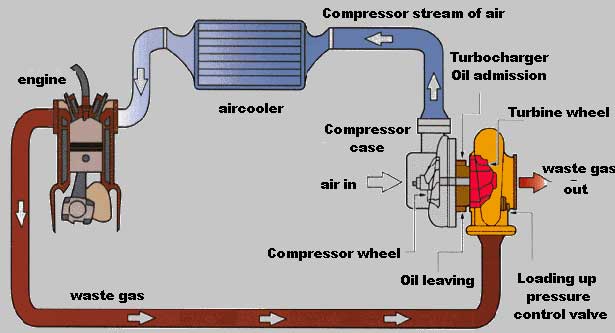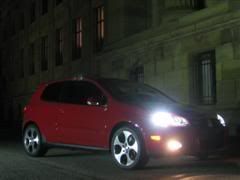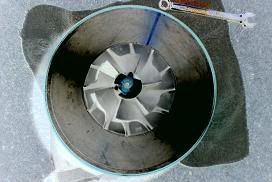Level One: Turbo Noobs.
Basic Components of a Turbo Kit
Wastegate (WG): Regulates the amount of boost (psi) the turbo is to produce. It does so by limiting the amount of exhaust flow driven directly at the turbocharger. The wastegate is hooked up to a vacuum source. There are two types of wastegates, internal and external.
-Internal Wastegate: incorporated within the turbocharger. It is comprised of a wastegate flapper as well as actuator. The actuator has diaphragm that is connected to a vacuum source (charge pipe, intake manifold). When this source reaches the preset pressure, it will open the flapper and allow the excess exhaust flow to exit without running into the turbine.

-External Wastegate: is separate form the turbo. Usually, it is mounted on the exhaust manifold. However, depending on the type of turbocharger used, it can be mounted on the WG flapper’s dump (advanced).

Turbocharger: The heart of your turbo kit. They come in many different sizes and colors but they all have the same parts. The “dull” side is the turbine side of the turbo. It’s usually called the “hot side” because the engine’s exhaust gas is driven through it, which turns the turbine. The turbine is connected to a shaft, which is connected to another wheel, which is designed to draw in the air. This side is known as the compressor side. This side is responsible for drawing in the air and pressurizing it.

Charge Pipes: The route for the compressed air from the turbo to the intake manifold.
Turbo Manifold: routes the engine’s exhaust gases to the turbo. In the case of external wastegate applications, there is an extra pipe coming off the collector, with a flange. This is how you would tell an internal wastegate manifold (no flange) from an external wastegate manifold (pipe & flange).

Ramhorn style Manifold

Unequal length manifold

The log style
Front Mount Intercooler (FMIC): Intercooler that is mounted in front of the car. It is the optimal air-to-air intercooler due to its distance from the engine bay. They are also mounted in front of the car, usually behind the front bumper cover.

Side Mount Intercooler (SMIC): Found in most stock applications. It employs the same principles as the FMIC, except is located inside the engine compartment. This intercooler is more discreet, however they are less efficient. Due to it being in the engine bay, they are subject to high temperatures.


Blow Off Valve (BOV): Most people know these as the things that make the *PSSHT* sounds. True, however it plays a major role in protecting the turbo. See, when the throttle body(s) during shifts, the excess boost needs somewhere to go. The BOV opens and released the excess boost into the atmosphere.


Fuel Management: There are many different types of fuel management available. Based on your budget as well as horsepower goals, you would pick which one best suits your setup.
-Standalone ECUs: These are the most expensive of your options and the best. They have the capability of running your turbocharged application as if it were a stock application. However, this kind of comfort comes at a high price, usually in the thousands. Common manufacturers are Motec, AEM and Haltech.
-Chipped ECUs: The affordable alternative to Standalones. Their cost can be from anywhere around 140-600 dollars, depending on the program. They come with features found in the standalone, however they cannot be modified as easily. When ever the user/tuner wants to change the tune, a new chip must be burned in order to do so.
-Piggyback ECUs: These are good way of controlling your fuel needs. They get the name piggyback, because they are usually mounted on top of the stock ECU. They function by intercepting ECU signals and feedback and modifying it to suit your needs.
-ECU Hacks: These are your VAFCs and SAFCs. These inputs are modified by the user and require quite a bit of knowledge to tune with. Unfortunately, by its nature the ECU is unaware of the altered fuel signal. This makes tuning very critical.
-FMUs: Fuel Management Units are the cheapest but most inefficient way of modifying your fuel. They raise inline pressure to force more fuel into the cylinder every time the injectors open. Due to this, they are incredibly dificult to tune.
Frequently Asked Questions
What is the purpose of a Blow-off Valve?
The BOV’s purpose is to protect the compressor from a condition called compressor surge. Compressor surge is a condition where excess boost has nowhere to go when the throttle body is closed between shifts. Repeated compressor surge erodes the fins of the compressor wheel and eventually can cause this:


What is the purpose of a Wastegate?
The purpose of a wastegate is to set the turbo to put out a desired amount of boost.
What is a DSM manifold?
Diamond Star Motors exhaust manifold, a.k.a. the Mitsubishi Eclipse, Eagle Talon, and Plymouth Laser. The Accord and Prelude engines have a similar port pattern. This allows us to use the DSM exhaust manifold by simply redrilling to match the screw locations of the Accord/Prelude engines.
What is the optimum compression for running a turbo?
Depends on the tuner. Higher compression allows for a more efficient setup. Every psi will yield you more hp. However tuning these higher compression setups are very intense. In most cases, an engine builder will seek to lower the compression to allow for an easier tuning session.
What’s a wastegate actuator?
The wastegate actuator is part of the wastegate that pushes the flapper to allow the exhaust gas to bypass the turbo.
What controls boost pressure?
The wastegate controls the boost pressure.
What does an intercooler do?
When air is compressed, it becomes really hot. The intercooler’s purpose is to cool off this compressed air.
What is turbo lag?
Turbo lag is the time it takes for your turbo to crossover to boost and reach the desired psi (or point where its efficient)
Who makes turbos (companies)?
Garrett/AiResearch is the prominent maker of turbos. There are other companies like Mitsubishi, Toyota and Nissan that manufacture their own turbos for their cars.
Can nitrous be used in conjunction with a turbo?
Nitrous can definitely be used with a turbo as long as the tune of the setup can accommodate it. Nitrous generates plenty of extra heat. It is recommended that the block is properly built and coated to withstand such heat. Provisions like an oil-cooler would be beneficial in these kinds of setups.
Is it necessary to upgrade the fuel system for turbo?
It is in-fact necessary to upgrade your fuel system to accommodate turbos. The turbos put out more air. Without more fuel you will create a dangerously lean condition. To prevent such conditions, a fuel upgrade consisting of at least larger injectors should be made. The injectors are in the front line when it comes to turbo charging. There are other items such as FMU’s, FPR’s, Fuel pump, rails, and filters that can be considered based your power goal.
What does sleeving do?
Resleeving is a process in which an engine block is fitted with new cylinder walls. In F22 applications, it can allow us to use bigger bore pistons, as well as eliminate a condition known as cylinder walk. Cylinder walk is commonly found in open deck applications.
What’s the difference between an open deck and a closed deck?
An open deck block has its cylinder sleeves separate from the block castings. It makes the block lighter as well as cooler. However, it is not good for performance, as it allows cylinder walk or cylinder rocking. And example of a open deck block would be a F22Ax. A closed deck block is a block where the sleeves are pressed into the block casting. These blocks are stable under heavy boost pressure.
What is a block guard?
A inexpensive route to ensure the cylinder sleeves of an open deck block do not move while under boost. It usually is welded into the block.
Should your piston heads be changed? If so, what is the difference between flat top, dish top, high dome, and low dome?
Depending on your compression goals you would change your pistons. When looking at turbo, the optimal piston for ease of tuning is the dish tops. They generate the least compression out of the available choices.
Basic Components of a Turbo Kit
Wastegate (WG): Regulates the amount of boost (psi) the turbo is to produce. It does so by limiting the amount of exhaust flow driven directly at the turbocharger. The wastegate is hooked up to a vacuum source. There are two types of wastegates, internal and external.
-Internal Wastegate: incorporated within the turbocharger. It is comprised of a wastegate flapper as well as actuator. The actuator has diaphragm that is connected to a vacuum source (charge pipe, intake manifold). When this source reaches the preset pressure, it will open the flapper and allow the excess exhaust flow to exit without running into the turbine.

-External Wastegate: is separate form the turbo. Usually, it is mounted on the exhaust manifold. However, depending on the type of turbocharger used, it can be mounted on the WG flapper’s dump (advanced).

Turbocharger: The heart of your turbo kit. They come in many different sizes and colors but they all have the same parts. The “dull” side is the turbine side of the turbo. It’s usually called the “hot side” because the engine’s exhaust gas is driven through it, which turns the turbine. The turbine is connected to a shaft, which is connected to another wheel, which is designed to draw in the air. This side is known as the compressor side. This side is responsible for drawing in the air and pressurizing it.

Charge Pipes: The route for the compressed air from the turbo to the intake manifold.
Turbo Manifold: routes the engine’s exhaust gases to the turbo. In the case of external wastegate applications, there is an extra pipe coming off the collector, with a flange. This is how you would tell an internal wastegate manifold (no flange) from an external wastegate manifold (pipe & flange).

Ramhorn style Manifold

Unequal length manifold

The log style
Front Mount Intercooler (FMIC): Intercooler that is mounted in front of the car. It is the optimal air-to-air intercooler due to its distance from the engine bay. They are also mounted in front of the car, usually behind the front bumper cover.

Side Mount Intercooler (SMIC): Found in most stock applications. It employs the same principles as the FMIC, except is located inside the engine compartment. This intercooler is more discreet, however they are less efficient. Due to it being in the engine bay, they are subject to high temperatures.


Blow Off Valve (BOV): Most people know these as the things that make the *PSSHT* sounds. True, however it plays a major role in protecting the turbo. See, when the throttle body(s) during shifts, the excess boost needs somewhere to go. The BOV opens and released the excess boost into the atmosphere.


Fuel Management: There are many different types of fuel management available. Based on your budget as well as horsepower goals, you would pick which one best suits your setup.
-Standalone ECUs: These are the most expensive of your options and the best. They have the capability of running your turbocharged application as if it were a stock application. However, this kind of comfort comes at a high price, usually in the thousands. Common manufacturers are Motec, AEM and Haltech.
-Chipped ECUs: The affordable alternative to Standalones. Their cost can be from anywhere around 140-600 dollars, depending on the program. They come with features found in the standalone, however they cannot be modified as easily. When ever the user/tuner wants to change the tune, a new chip must be burned in order to do so.
-Piggyback ECUs: These are good way of controlling your fuel needs. They get the name piggyback, because they are usually mounted on top of the stock ECU. They function by intercepting ECU signals and feedback and modifying it to suit your needs.
-ECU Hacks: These are your VAFCs and SAFCs. These inputs are modified by the user and require quite a bit of knowledge to tune with. Unfortunately, by its nature the ECU is unaware of the altered fuel signal. This makes tuning very critical.
-FMUs: Fuel Management Units are the cheapest but most inefficient way of modifying your fuel. They raise inline pressure to force more fuel into the cylinder every time the injectors open. Due to this, they are incredibly dificult to tune.
Frequently Asked Questions
What is the purpose of a Blow-off Valve?
The BOV’s purpose is to protect the compressor from a condition called compressor surge. Compressor surge is a condition where excess boost has nowhere to go when the throttle body is closed between shifts. Repeated compressor surge erodes the fins of the compressor wheel and eventually can cause this:


What is the purpose of a Wastegate?
The purpose of a wastegate is to set the turbo to put out a desired amount of boost.
What is a DSM manifold?
Diamond Star Motors exhaust manifold, a.k.a. the Mitsubishi Eclipse, Eagle Talon, and Plymouth Laser. The Accord and Prelude engines have a similar port pattern. This allows us to use the DSM exhaust manifold by simply redrilling to match the screw locations of the Accord/Prelude engines.
What is the optimum compression for running a turbo?
Depends on the tuner. Higher compression allows for a more efficient setup. Every psi will yield you more hp. However tuning these higher compression setups are very intense. In most cases, an engine builder will seek to lower the compression to allow for an easier tuning session.
What’s a wastegate actuator?
The wastegate actuator is part of the wastegate that pushes the flapper to allow the exhaust gas to bypass the turbo.
What controls boost pressure?
The wastegate controls the boost pressure.
What does an intercooler do?
When air is compressed, it becomes really hot. The intercooler’s purpose is to cool off this compressed air.
What is turbo lag?
Turbo lag is the time it takes for your turbo to crossover to boost and reach the desired psi (or point where its efficient)
Who makes turbos (companies)?
Garrett/AiResearch is the prominent maker of turbos. There are other companies like Mitsubishi, Toyota and Nissan that manufacture their own turbos for their cars.
Can nitrous be used in conjunction with a turbo?
Nitrous can definitely be used with a turbo as long as the tune of the setup can accommodate it. Nitrous generates plenty of extra heat. It is recommended that the block is properly built and coated to withstand such heat. Provisions like an oil-cooler would be beneficial in these kinds of setups.
Is it necessary to upgrade the fuel system for turbo?
It is in-fact necessary to upgrade your fuel system to accommodate turbos. The turbos put out more air. Without more fuel you will create a dangerously lean condition. To prevent such conditions, a fuel upgrade consisting of at least larger injectors should be made. The injectors are in the front line when it comes to turbo charging. There are other items such as FMU’s, FPR’s, Fuel pump, rails, and filters that can be considered based your power goal.
What does sleeving do?
Resleeving is a process in which an engine block is fitted with new cylinder walls. In F22 applications, it can allow us to use bigger bore pistons, as well as eliminate a condition known as cylinder walk. Cylinder walk is commonly found in open deck applications.
What’s the difference between an open deck and a closed deck?
An open deck block has its cylinder sleeves separate from the block castings. It makes the block lighter as well as cooler. However, it is not good for performance, as it allows cylinder walk or cylinder rocking. And example of a open deck block would be a F22Ax. A closed deck block is a block where the sleeves are pressed into the block casting. These blocks are stable under heavy boost pressure.
What is a block guard?
A inexpensive route to ensure the cylinder sleeves of an open deck block do not move while under boost. It usually is welded into the block.
Should your piston heads be changed? If so, what is the difference between flat top, dish top, high dome, and low dome?
Depending on your compression goals you would change your pistons. When looking at turbo, the optimal piston for ease of tuning is the dish tops. They generate the least compression out of the available choices.













Comment